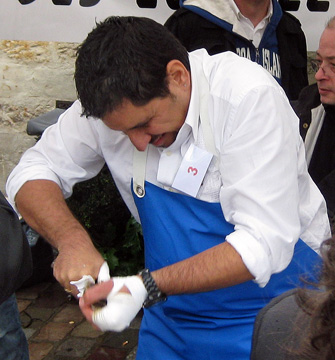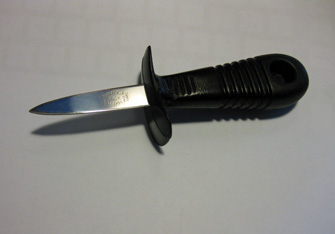 |
|
There’s no accounting for it: people either love oysters or hate them. But I can guarantee that by the time they reach the condition shown here, oysters hate people. |
As I have mentioned from time to time, it so happens that I grew up in the Midwestern United States. Everybody has to start somewhere. One of the many things that we Midwesterners learn to live without is a seashore. In fact, the little town I called home until about three seconds after receiving my high school diploma is, roughly, the same distance from the nearest body of saltwater in any direction: west to the Pacific, east to the Atlantic, south to the Gulf of Mexico and North to Hudson Bay.
Growing up so far from any surf, surrounded by so much turf, has several adverse effects. In retrospect, the worst ones for me were, listed in order of increasing hardship:
1. Tornadoes,
2. It took many, many long hours of driving past cornfields to reach any destination worthy of the description “picturesque” or “interesting,”
3. It made it seem really ridiculous to be a Beach Boys fan,
4. No oysters.
As a little boy, I was aware that there were these hard-shelled ocean-dwelling creatures called oysters, but I never saw one until I was in my 20s and attending graduate school in New England. Actually, that’s not quite true: once in high school I attended a party at which allegedly fancy hors d’oeuvres were served, and one of the little platters contained the contents of a jar of pickled oysters from the “gourmet” section of the supermarket. That doesn’t count. Those oysters were separated from their shells, cooked and preserved in vinegar, probably before I was born. A real oyster is served raw, plucked from the seabed just hours before, freshly shucked and sitting there wet and glistening on its bottom shell, ready to receive a spritz of juice from a lemon wedge, slip crisply into my eager mouth, delight my tingling tongue, and then slide smoothly down my enraptured throat and into my grateful stomach. (Don’t worry, I’ll stop there.)
Oh — perhaps I should mention: I like raw oysters. In fact, I love raw oysters and have loved them since the very first time I ate one, an event that took place about three seconds after the very first time I heard that it was possible to eat them raw.
The population of the world can be divided neatly into two groups: oyster lovers and oyster haters. Members of the latter group recoil at the texture, flavor and very idea of raw oysters. They point out, with some justification, that the look and consistency of a fresh, uncooked oyster not only makes them want to gag, but resembles the substance that results from gagging, especially during cold season, and the thought of this makes them want to gag again, thus triggering a self-perpetuating cycle of revulsion. A viscous circle, so to speak.
I, on the other hand, am firmly in the love camp. I love the texture, the briny freshness, the tinge of oceanic pungency and the watery yet flavor-packed succulence. And, I suppose, somewhere in the back of my mind I love the idea of eating something that I couldn’t have procured for any amount of money, gold bullion or sexual services back in the old hometown. Or even in Omaha!
When I moved to Paris, one of the things I liked most about the city was the easy availability of fresh oysters. You can get various varieties by the dozen at any fishmonger’s shop and many restaurants offer them as an appetizer. However, for my first decade or so here, my oyster feasting was confined to restaurants, because I didn’t know how to open them. I tried once, for a New Year’s Eve party at which the hostess had stocked a few dozen fines de claire (the French equivalent of blue points), figuring that someone would be able to crack them open. A small group of stalwarts, including me, took a crack at it, but the results were pathetic. We didn’t have the proper equipment and wouldn’t have known how to use it if we had. We assaulted those poor mollusks with every DIY tool we could find, from pocketknives to chisels to screwdrivers. At one point we were considering the power sander.
It wasn’t a pretty sight. By the time we finished mangling them, our oysters were an amorphous mass of green and gray glop coated with tiny chips of shell and mother-of-pearl. The only way to render them edible was to wash them under running water, which removes about half of the flavor. So it was more or less like eating those twenty-year-old cocktail oysters back in the Dirt Belt, but with a dusting of residual grit.
That was when I learned that it’s really hard to open an oyster. They stay alive for a long time out of the water, but once they are taken away from their homes, friends, comfort zones and support groups, they tend to clam up (or in some cases mussel up), concentrating all of their physical and mental energy, such as it is, on one thing: staying clamped closed as tightly as is oysterly possible. Which is very tightly. Blue-ribbon tightly. Olympic-class tightly. An oyster’s body is basically one big muscle with a digestive tract added as an afterthought, and that muscle evolved over countless whazillions of millennia to serve one purpose, namely to keep the bivalve’s two valves hermetically sealed. Even with our vastly superior organ diversity, limb leverage, dexterity and muscle mass, we humans have a hard time overcoming the oyster’s mulish determination.
So it came as a welcome realization when I found out that most fish shops in Paris are only too happy to open oysters for their customers. The one up the street from me charges one solitary shiny euro per dozen to shuck them cleanly and place them carefully (with all of their juice preserved) either in a plastic bucket or on a platter surrounded by whatever other marine delicacies — shrimp, crabs, langoustines, etc. — one might desire.
Nonetheless, I wanted to learn to open the little critters myself. I bought one of those squat, broad oyster knives and, by trial and error, got better at it after a while, to the point that I now ruin only about one out of every dozen. So I’m still no master. Also, I am petrified of hurting myself, because to open an oyster you have to push a razor-sharp blade with great force into a rocklike object held in your other hand. One slip and your dinner gets postponed while you rush to the emergency room. Not wishing to find myself in the awkward position of trying to convince an ambulance crew that I didn’t slash my wrists on purpose, I always wrap up my left hand with three or four thicknesses of towels.
That’s why professional oyster shuckers, the people who open them for a living in a fish shop or restaurant, mystify me. Every time I see them at work, they’re never, never, never wearing any kind of protection on either hand. I had always assumed that it was one of those phenomena like taxi drivers never wearing a seatbelt — professional pride and confidence, tempered with a dash of senseless hubris — or that it was indeed possible to hone the technique to the point that protection was unnecessary. But then I went to France’s annual National Oyster Shucking Championship at Bercy Village in eastern Paris a couple of weeks ago and saw this:
 |
|
Maybe, just maybe, my abiding fear of knife slippage is well-founded. |
All of the contestants had the fingers and thumb of at least one hand wrapped up like ancient Egyptian finger puppets. And I doubt that the tape was to ward off tendinitis.
Speaking of slipping and slicing, another thing that unites professional oyster openers is that they never, never, never use a regular oyster knife, like the one I have:
 |
|
It’s cheap and clumsy, but at least it has a protective hilt. |
The competitors at Bercy were using what looked like run-of-the-mill paring knives, but it didn’t hold them back. Look at this guy in action in the speed trials:
|
An oyster opened every three seconds, and he didn’t even come in third. |
I discussed the cutlery issue once with a fishmonger in Antibes, who had very graciously agreed to give me a short course in shellfish shucking. I showed him the knife I had bought, which he immediately dismissed as being “for amateurs.” His weapon of choice was a small but vicious-looking folding knife with a blade so slim and sharp it could have been used to epilate a sleeping gorilla without waking him up. And there was no anti-slip guard on the handle either.
I greatly appreciated his advice on how to pop open the shell and free the oyster from its carapace, and I tremendously appreciated the six or seven belons that he let me sample for free as part of the demonstration, but there was no way I was going to switch to one of those suicide scalpels. To this day, my desire to employ the right kind of equipment is outweighed by my desire to keep my epidermis intact and my blood inside my arteries, out of sight. Still, sticking with my minor-league knife, I aspire to reach the point where I can open them as well, if not as fast, as that guy at Bercy. Because I fully expect that the day will come when I go out to get oysters and find that all of the professional shuckers are off work — half of them at the hospital getting stitches and the other half on strike for hazard pay.
Follow C’est Ironique on Facebook
© 2011 Paris Update
FavoriteAn album of David Jaggard’s comic compositions is now available for streaming on Spotify and Apple Music, for purchase (whole or track by track) on iTunes and Amazon, and on every other music downloading service in the known universe, under the title “Totally Unrelated.”
Note to readers: David Jaggard’s e-book Quorum of One: Satire 1998-2011 is available from Amazon as well as iTunes, iBookstore, Nook, Reader Store, Kobo, Copia and many other distributors.
